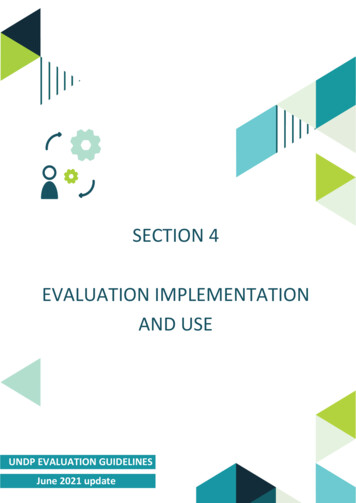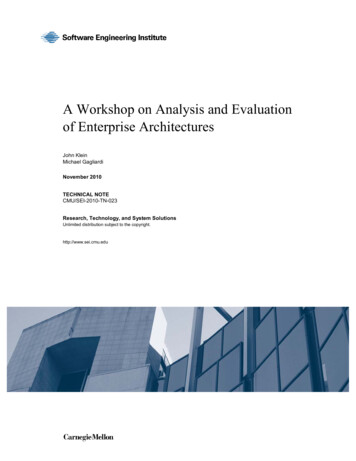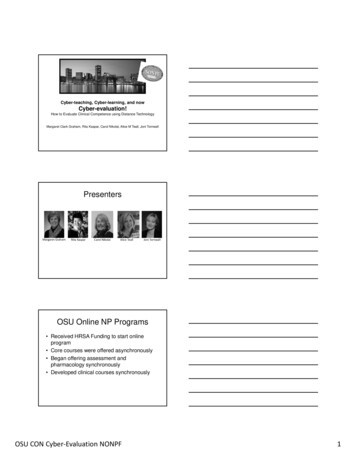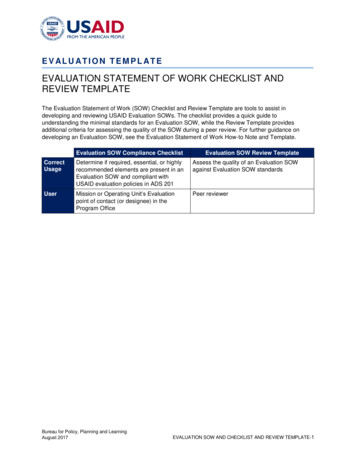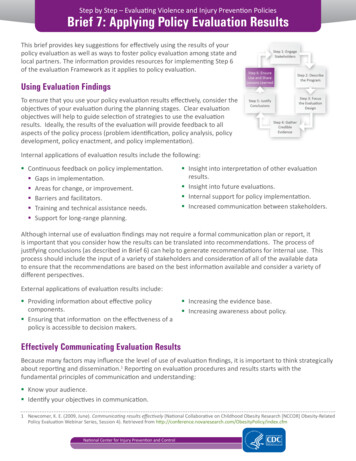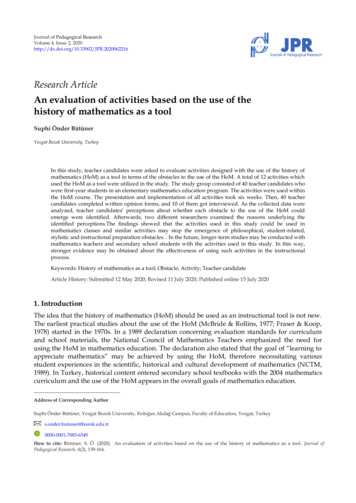
Transcription
Journal of Pedagogical ResearchVolume 4, Issue 2, rch ArticleAn evaluation of activities based on the use of thehistory of mathematics as a toolSuphi Önder Bütüner1Yozgat Bozok University, TurkeyIn this study, teacher candidates were asked to evaluate activities designed with the use of the history ofmathematics (HoM) as a tool in terms of the obstacles to the use of the HoM. A total of 12 activities whichused the HoM as a tool were utilized in the study. The study group consisted of 40 teacher candidates whowere first-year students in an elementary mathematics education program. The activities were used withinthe HoM course. The presentation and implementation of all activities took six weeks. Then, 40 teachercandidates completed written opinion forms, and 10 of them got interviewed. As the collected data wereanalyzed, teacher candidates‟ perceptions about whether each obstacle to the use of the HoM couldemerge were identified. Afterwards, two different researchers examined the reasons underlying theidentified perceptions.The findings showed that the activities used in this study could be used inmathematics classes and similar activities may stop the emergence of philosophical, student-related,stylistic and instructional preparation obstacles. . In the future, longer-term studies may be conducted withmathematics teachers and secondary school students with the activities used in this study. In this way,stronger evidence may be obtained about the effectiveness of using such activities in the instructionalprocess.Keywords: History of mathematics as a tool; Obstacle; Activity; Teacher candidateArticle History: Submitted 12 May 2020; Revised 11 July 2020; Published online 15 July 20201. IntroductionThe idea that the history of mathematics (HoM) should be used as an instructional tool is not new.The earliest practical studies about the use of the HoM (McBride & Rollins, 1977; Fraser & Koop,1978) started in the 1970s. In a 1989 declaration concerning evaluation standards for curriculumand school materials, the National Council of Mathematics Teachers emphasized the need forusing the HoM in mathematics education. The declaration also stated that the goal of “learning toappreciate mathematics” may be achieved by using the HoM, therefore necessitating variousstudent experiences in the scientific, historical and cultural development of mathematics (NCTM,1989). In Turkey, historical content entered secondary school textbooks with the 2004 mathematicscurriculum and the use of the HoM appears in the overall goals of mathematics education.Address of Corresponding AuthorSuphi Önder Bütüner, Yozgat Bozok University, Erdoğan Akdağ Campus, Faculty of Education, Yozgat, 549How to cite: Bütüner, S. Ö. (2020). An evaluation of activities based on the use of the history of mathematics as a tool. Journal ofPedagogical Research, 4(2), 139-164.
S.Ö.Bütüner / Journal of Pedagogical Research, 4(2), 139-164140In the literature, the use of the HoM has been encouraged by many researchers in mathematicsclasses (Fauvel, 1991; Fried, 2001; Gulikers & Blom, 2001; Liu, 2003; Jankvist, 2009; Haverhals &Roscoe, 2010; Wang, Qi & Wang, 2017; Baki & Gürsoy, 2018). The contributions of the HoM to thedevelopment of students‟ cognition and affect as well as teachers‟ subject area and pedagogicalknowledge have been reported (Furinghetti, 2007; Huntley and Flores, 2010; Clark, 2012). Despitethe mention of the positive effects of the HoM on students and teachers, the literature also citesmany obstacles resulting from its misuse (Tzanakis & Arcavi, 2002; Siu, 2007; Ho, 2008; Horton,2011; Clark et al., 2018). Man-Keung Siu (2007) mentions sixteen obstacles to the use of the HoM ina study entitled “No, I do not use the HoM in my class, why?” S1.I do not have enough time.S2.History is not mathematics.S3.How can I include questions about the HoM in my exams?S4.It does not contribute to student grades.S5.Students do not like it.S6.Students take the HoM as history class and they hate history.S7.Students find topics in the HoM as boring as those in mathematics.S8.There is a shortage of materials in the HoM.S9.I am not a professional mathematics historian. How, then, can I be sure about theaccuracy and reliability of my practices?S10.Teachers lack training in effectively using the HoM.S11.Students do not have enough information on cultures to be able to evaluate thepractices.S12.The goal in mathematics is to solve difficult routine problems. Why should we goback in time then?S13.It may confuse students by complicating mathematical concepts instead of clarifyingthem.S14.Will the challenging task of reading original texts be useful?S15.Will it lead to cultural chauvinism?S16.Are there any studies showing that the use of the HoM improves student learning?Previous studies have also shown a similarity to the obstacles mentioned above. Dickey (2001)studied the effects of the use of the HoM on eighth graders‟ learning and attitudes. The resultsshowed that some students worried about scoring poorly on mathematics exams as a result of theHoM activities, falling behind the schedule and not being able to learn worthwhile knowledge. Lit,Siu and Wong (2001) conducted an experimental study using the HoM in mathematics instruction.They found that experimental students took more pleasure out of the learning process in theaffective dimension, while their achievement level was lower than those in the control group in thecognitive dimension. The researchers commented that this may be explained by studying therelationship between the content taught to students and how they evaluate it. They added that testscores may be affected by knowing the accurate rules and formula, being able to correctly usethem in questions and by student pace in solving a mathematical problem. They therefore arguedthat student test scores cannot explain the effects of the HoM on achievement. In a different study,Tözluyurt (2008) used the HoM activities with high school freshmen. All of their studentspreferred to carry out multiplication in the modern way, stating that multiplication in ancientEgypt had to be used by lower classes. They also stated that hieroglyph use was difficult andirrelevant to today‟s mathematics. Using the case study method, Kaye (2008) gave a videoconference to teachers and 10 year old students from four schools on Babylonian mathematics. Allof them had difficulty writing Babylonian numbers. Fraser and Koop (1978) asked the views of 39mathematics teachers about certain the HoM instructional materials. The materials included a playon Thales‟ life and an article about conic history. Of the teachers, 14 stated that the play was timeconsuming and 6 stated that the article was the same. While 13 teachers argued that they did not
S.Ö.Bütüner / Journal of Pedagogical Research, 4(2), 139-164141possess the knowledge or experience to be able to use plays, 10 mentioned the same complaintabout using articles. Equally noteworthy was that 36 teachers agreed that plays were inaccessibleto them, while 32 stated that articles were inaccessible. Eleven teachers stated that they would notuse plays in their classes and 17 stated that they would not use articles. Although teachers mostlyheld positive views about the activities, they also confessed that they would not use such materialsin their instruction again. Panasuk and Horton (2012) investigated whether mathematics teachersused the HoM in their classes and their reasons why. Those who did not include the HoM in theirclasses listed their reasons as follows: lack of knowledge and skills on the use of the HoM, lack ofresources, time limitations, mismatch between these materials and real exams. Gazit (2013)endeavored to identify the HoM knowledge level of mathematics teachers, and concluded that thelevel was rather low.Tzanakis and Arcavi (2002) divided the obstacles before the use of the HoM in two categories:philosophical and practical obstacles. Haverhals and Roscoe (2010) treated Keung Siu‟s (2007)obstacles in the following categories: “philosophical obstacles (S1, S2, S12)”, “student relatedobstacles (S5, S6, S7, S11)”, “structural obstacles (S3, S4, S13, S14)”, and “preparation for instruction(S8, S9, S10)”. Another taxonomy of the obstacles to the use of the HoM put forward two differentcategories: “epistemological and method based obstacles” and “obstacles related toimplementation-the nature of instruction” (Clark et al., 2018). Considered as a whole, all theseresearchers appear to support a common view regarding the obstacles to the use of the HoM. Theresults of previous research suggest that the obstacles to the use of the HoM include “the mismatchbetween historical content and the contents of current mathematics textbooks”, “students finding itdifficult and complex” and “mathematics teachers lacking the knowledge and experience in usingthe HoM”. This study enabled teacher candidates to work on activities conducive to using theHoM as a tool and asked them to evaluate these activities in relation to whether they would createobstacles to the use of the HoM. The next part will explain the rationale of the study and itscontributions to the field.1.1. Rationale for the StudyAs mentioned before, the literature mentions that there are certain obstacles to the use of the HoMdespite its positive effects. While some studies report student benefits with the use of the HoM,others argue that the historical content is thought to be complicated, unnecessary and unpleasantby the students. Therefore, it is important to investigate how the HoM can be used in instructionalenvironments. This may help prevent some of the problems emerging from the misuse of theHoM. This study aims to reveal whether the above-mentioned problems would still emerge as aresult of using the HoM by a tool in line with teacher candidate views. The twelve activities in thestudy were prepared by considering the obstacles to the use of the HoM, and the following wereensured in order to prevent the emergence of the obstacles: It was ensured that the contents of activities were congruent with the contents of secondaryand high school mathematics textbooks. The contents of activities were designed to teach a mathematical concept, rule or formulafrom current mathematics textbooks. Problem solutions aimed to teach interesting and different solution methods which presentalternatives to current mathematics textbooks. Students were motivated by showing the role and importance of mathematics in society.Another noteworthy aspect of the activities was that they encouraged students to discovermathematical rules and formula through paper cutting and pasting, decomposing and combining.It is believed that such use of the HoM may alleviate the obstacles mentioned before. This studymay assist teachers and teacher candidates to use the HoM in their classes effectively. Also, it mayguide future researchers when preparing HoM activities. The use of mathematics history as a tooland the activities used in this study are explained below.
S.Ö.Bütüner / Journal of Pedagogical Research, 4(2), 139-1641421.2. Using the HoM as a ToolIn this study, teacher candidates were asked to evaluate activities designed to use the HoM as atool by considering the obstacles to doing so. The use of the HoM as a tool aims to improve notonly students‟ knowledge of mathematical concepts but also their motivation towards learningmathematical concepts (Swetz, 1997; Ernest, 1998; Furinghetti & Somaglia, 1998; Marshall & Rich,2000, Liu, 2003; NCTM, 2006). Jankvist‟s (2009a,b) views on the use of the HoM as a tool are givenin Table 1.Table 1.The Use of the HoM as a Tool (Jankvist, 2009a,b)1The HoM is used to teach mathematical topics and concepts and to determine theproblems experienced by students (epistemological obstacles)2The HoM is used to show students that even famous mathematicians made mistakes whensolving problems and spent a long time on developing their solutions, and to make thembraver and more persistent in the problem solution process3The HoM is used to enable students to solve problems by using different approaches andto learn a mathematical concept or relation4The HoM is used to make students compare new and old ways of solving problems orusing symbols, and realize the advantages of new methods5The HoM is used by teachers to better teach mathematical topics and increase theirstudents‟ motivation6The HoM is used to increase teachers‟ mathematics literacy levelsThe twelve activities used in the study were designed in line with the use of the HoM as a tool.Appendix 1 shows the resources used in the preparation of the activities. It also includesinformation on them. The activities used in the study aimed to make students discovermathematical rules, formula and connections; solve problems; and understand the role andsignificance of mathematics in the society. The HoM was therefore used as a tool. While thestudents worked on the activities, they were supposed to construct their own new knowledge byusing their previous experiences. For example, activity 12 asks students to use the areas ofgeometric objects when discovering the rule for sum of consecutive positive whole numbers. Thisis a previously learned piece of knowledge for the students. Therefore, they use existingknowledge and build upon it when constructing new knowledge. The activities expect students todiscover mathematical rules and formula themselves. As can be seen, the instructional philosophyof the constructivist approach was adopted when preparing the HoM activities. Below, there isinformation about how activities 1, 3 and 6 are in line with the use of the HoM as a tool (how theycan contribute to students‟ cognitive and affective development) and how obstacles to the use ofthe HoM may be prevented. In addition, activities 1, 3, 4, 8 and 9 are given in Appendix 2.Secondary school students often confuse the rule of signs in multiplication. Therefore, whenteaching the use of signage in multiplication in Grade 7, the alternative method of Jean-RobertArgand‟s (1768-1822) direction idea can be used (Figure 1). Jean-Robert Argand (1768-1822) was anamateur French mathematician. He published the Argand diagram, also known as complexnumbers, with geometric interpretations. Let us assume that we are to multiply 1 and i in thisdiagram. Both 1 and i have positive direction. As one proceeds from 1 to i counter-clockwise, theresult will be positive. Therefore 1xi i. When 1 and -i are being multiplied, 1 has positive direction,and -i has negative. As one proceeds from 1 to -i clockwise, the result will be negative. Therefore1x-i -i (Sip, 1990). The French mathematician Argand‟s idea is also true for the multiplication oftwo whole numbers. For example, below in the 3x(-2) operation, first 3 and -2 are shown in the
S.Ö.Bütüner / Journal of Pedagogical Research, 4(2), 139-164143vertical coordinate system. As 3 is in the x axis and -2 is in the y axis, and one proceeds from 3 to -2(from the x to the y axis) clockwise, it is clear that the result will be negative. It is -6. This activityprovided students with an alternative method to remind them of the rule of signs inmultiplication. It therefore serves the use of the HoM as a tool.Figure 1. Jean-Robert Argand‟s rule of signs in multiplicationActivity 3 was prepared to help students conceptually learn the long form of. In theancient Chinese document titled Jiuzhang Suanshu, they reached the long form ofbyusing the method of disintegrating and combining the parts (Dauben, 2007; Huntley and Flores,2011). In this method, they calculated the volume of the geometric objects below (Figure 2) to findthe open form of. As the activity aimed to teach the students the long form of, itis in line with the use of the HoM as a tool.Figure 2. Geometric models used for the long form ofIn activity 6, students were presented with the length measurement units used in ancient times(Figure 3) and then they were asked to use these units to measure the length of various objects,compare their results and interpret the differences in the results. In this way, they were given anopportunity to understand the importance of using standard measurement units (the use of theHoM as a tool). The length measurement units used in ancient Egypt in 2500 B.C. are shown below(Dilke, 1993; Lumpkin, 1997a).Figure 3. Length measurement units in ancient Egypt (Lumpkin, 1997a, p.8)
S.Ö.Bütüner / Journal of Pedagogical Research, 4(2), 139-1641442. Method2.1. Study Model and ParticipantsIn this qualitative case study, teacher candidates were asked to evaluate activities based on the useof the HoM as a tool with respect to the obstacles to the use of the HoM. The study group consistedof 40 teacher candidates who were first year students at a public university. The study sample wasselected by using the purposive sampling method of easy access case sampling. Teachercandidates were attending the elementary mathematics education undergraduate program.2.2. Data Collection ProcessThe study used 12 activities based on the use of the HoM as a tool. The activities wereimplemented in the HoM course, which is offered two-hour weekly during the first semester of theelementary mathematics education undergraduate program. The course aims to teach teachercandidates the contributions of different civilizations to mathematics and the historicaldevelopment of mathematical concepts. The researcher is a lecturer of the HoM course. Ernest(1989) divides the roles of teachers into three categories: explainer, instructor, and facilitator. In thepresent study, the researcher assumed a facilitating quasi-experimental role (learning as the activeconstruction of understanding). The introduction of the activities to the teacher candidates andtheir implementation took six weeks. Then, 40 teacher candidates completed written opinionforms, and 10 of them got interviewed. The questions on the written opinion form and interviewquestions were based on the obstacles mentioned in the literature against the use of the HoM. Thequestion on the written opinion form was: “Below is a list of the obstacles to the use of the HoM(For example, “Students do not like the HoM”). Considering each of the 12 activities you workedon, do you think that the use of this type of activities in the mathematics class would lead to suchobstacles? Explain your answer in detail. The participants were asked to provide a consolidatedopinion.2.3. Data AnalysisThe literature mentions two types of content analysis. In deductive content analysis, themesemerge from the research questions or the theoretical framework of the study. In inductive contentanalysis, on the other hand, categories are derived directly from the text. Deductive contentanalysis is not commonly used, but is nevertheless beneficial for testing concepts, categories,theories or any conceptual structure in a new context. Deductive content analysis is similar toinductive content analysis in that it is applied in qualitative research and the data collectionmethod aims to reach data saturation. The main difference between the two analytical techniquesis that research in which deductive content analysis is applied usually has prior theoreticalknowledge as the starting point. As such, the research questions are influenced by priorknowledge, and hence, affect the data collection stage.As in inductive content analysis, thereporting of results should be structured according to the identified concepts, categories and/orthemes. Elo and Kyngas, (2008) and Hsieh and Shannon, (2005), stated that when testing anexisting theoretical framework, the theoretical-deductive content analysis would work better. Inthe study, the data were analyzed in depth with respect to the main and sub themes identified inline with the theoretical framework of the study. In the analysis of the written and interview data,the main and sub themes were formed by using Haverhals and Roscoe‟s (2010) classification basedon the 16 obstacles stated by Keung Siu (2007). Therefore, data were analyzed with deductivecontent analysis. The analysis was carried out by observing the stages mentioned in the literature(Vaismoradi, Turunen and Bondas, 2013; Bengtsson, 2016; Erlingsson and Brysiewicz, 2017). Whenthe data from the written opinion form and interviews were analyzed, the written texts were readand re-read many times in order to gain an overall perspective on the data set. Following this, thewritten statements were underlined, and shortened in a way that would not change their meaning.Codes were then assigned to the shortened meaning units and suitable codes were organized
S.Ö.Bütüner / Journal of Pedagogical Research, 4(2), 139-164145together. The clusters thus formed were named by using the theoretical framework. Written textswere re-read repeatedly at different times to check the accuracy of the codes and whether theemerging codes belonged to the relevant main theme and sub theme. These were checked by adifferent researcher who specializes in qualitative research.2.4. Validity and ReliabilityThe 12 activities designed were examined by two academics specializing in the HoM and twomathematics teachers with respect to the use of the HoM as a tool, their congruence with contentsand objectives, and difficulty level. The activities were piloted on 8 teacher candidates and thusfinalized. The written opinions of 40 teacher candidates were obtained, followed by interviewsheld with ten teacher candidates. The sub-themes and codes were created by analysing teachercandidates‟ written opinions. In order to obtain accurate findings, data were read repetitively toget an overall impression. The written texts were re-read at different times in order to check theaccuracy of the coding and whether the resulting codes belonged to the relevant main and subthemes. Afterwards, these sub-themes and codes are confirmed with quotes taken from theinterviews with 10 teacher candidates. The codings was reviewed by a specialist on the use of theHoM in classes and qualitative methodology. Both were confirmed by the specialist. Leadingquestions were not used in this study. Researcher maintained neutrality so as to not influence theparticipants‟ responses. All collected data were analyzed with clear and unbiased mind. Questionsrequiring explanation were used instead of short answer questions.3. FindingsTeacher candidates worked on the 12 activities designed to use the HoM as a tool, and at the endof the study they provided written explanations about whether the use of the HoM as a tool wouldcause the obstacles mentioned in the literature and their reasons. Teacher candidates‟ writtenopinions about the emergence of philosophical obstacles when the HoM is used as a tool led to theemergence of four main categories: “The Contributions of the Activities to the Prevention ofPhilosophical Obstacles”, “The Contributions of the Activities to the Prevention of Student-RelatedObstacles”, “The Contributions of the Activities to the Prevention of Stylistic Obstacles”, “TheContributions of the Activities to the Prevention of Instructional Readiness Obstacles”.3.1. The Contributions of the Use of the HoM as a Tool to the Prevention of PhilosophicalObstaclesUnder this main category, there were three sub categories (“the activities do not cause timeissues”, “they are relevant to mathematics”, “the use of history is necessary”). Figure 4 shows thesub themes and codes which are created by analysing teacher candidates‟ written opinions.Afterwards, these sub themes and codes are provided with quotes taken from the interviews with10 teacher candidates.
S.Ö.Bütüner / Journal of Pedagogical Research, 4(2), 139-164146Figure 4. Subcategories and codes of the category “the contributions of the use of the HoM as a toolto the prevention of philosophical obstacles”Teacher candidates emphasized that the activities were related to the course objectives (f 39),supported permanent and meaningful learning (number of teacher candidates, f 34) and thehistorical content was used in a planned way in the activities (f 29), and stated that such use of theHoM would not lead to time problems.T2:HoM content concerns mathematics class. To illustrate, students finding the long form ofwith the Ancient Chinese method would not cause time loss because it is related to today’smathematics.T7:The activities presented the HoM in relation to current mathematical topics. They used theconcept of direction and Argand’s solution of 1x(-i) when teaching multiplication of whole numbers.If we relate the HoM to current topics, we won’t lose time.T11:Thanks to the activities, students can understand the underlying meaning of the rules and whatthey represent. Instead of spoon-feeding the rules, having students discover them in this way helpspermanent learning. Therefore, this is no waste of time.T4:As with the activities here, the use of materials in the classroom may steal some time, but this isnegligible because the students see, understand, and explore. For instance, they reach the volumeformula for the truncated square pyramid by using the method of cutting and disintegrating as inAncient Egypt.T21:The activities showed me that the right and planned use of the HoM does not lead to time loss. Imean, if you allocate a whole class hour to numbers in ancient Egypt, you may see the HoM as awaste of time. The activities here used the HoM in a planned way.T30:The activities were all about current mathematical concepts and rules. We could’ve also seenhistorical things not mentioned in mathematics books. For example, we could’ve had samples ofhistorical books, old representations. What is important is to use history with a plan, to manage ourtime in class.According to the teacher candidates, as the activities were tied to the course objectives (f 38)and included the bases of today‟s mathematics (f 12) they were relevant to mathematics. Interviewopinions supporting this can be seen below.
S.Ö.Bütüner / Journal of Pedagogical Research, 4(2), 139-164147T14:If we only use history as old notations, representations, old numbers, problem solutions inancient languages, of course everybody will think it is not mathematics but in our activities, welearned about the use of the HoM in teaching today’s mathematical topics. If it is used well, historycannot be thought of as separate from mathematics.T17:The activities were related to today’s mathematics; therefore, if these activities are used, studentsand teachers will not think that history cannot be mathematics.T9:Studies in the HoM form the basis of today's mathematics. In order to understand currentmathematics, students must know its history.T21: The past plays an important role in shaping today’s mathematics. Therefore, the HoM isrelevant to current mathematics.Teacher candidates agree that the use of the HoM is necessary. They stated that the use of theHoM was necessary; the activities contributed to permanent and meaningful learning (f 39) andvarious different solutions (f 21); they helped students to understand the role of mathematics indaily life (f 18) and its relations with other disciplines (f 14); and they develop students‟assumption skills (f 18).T32:What is important in mathematics is to understand where the rules to be used in problemsolutions come from and what they mean, rather than simple problem solution. The activities weretherefore rather effective in teaching the rule for the volume of the truncated square pyramid, and therule for the sum of consecutive positive Numbers. This type of activities should be used.T29:We may solve similarity questions with the rules given in school, but I saw that in ancientChina they were solved with the help of areas and by forming various figures. Thanks to the HoM,students may learn different solution methods. The HoM should therefore be utilized.T30:Problem solution is important in mathematics, but students should also know why mathematicsis important and why it should be used. For instance, interactivity about the birth of statistics, thestudents can learn why statistics is an important science. The HoM should therefore be incorporatedinto classes.T36:In the activity about the sum of consecutive positive whole and square numbers, students canbecome aware of the relationship between geometry and mathematics. In other words, they mayunderstand the relationship between different learning fields. This is why the HoM should be used inclasses.T17:In the activity about this sum of consecutive positive whole numbers and square whole numbers,they needed to use their previous knowledge in order to discover the rules. Four example, they neededto use the rule about the volume of a prism when finding the sum of square numbers.3.2. The Contributions of the Activities to the Prevention of Student-Related ObstaclesUnder this main category, there were two sub categories (“the students can evaluate the activities”,“they are not unpleasant or boring”). Figure 5 shows the sub themes and codes which are createdby analysing teacher candidates‟ written opinions. Afterwards, these sub themes and codes areprovided with quotes taken from the interviews with 10 teacher candidates.The teacher candidates stated that the activities they engaged in were relevant to courseobjectives (f 39) and that they did not require detailed knowledge about cultures (f 31). Theseviews showed that students can evaluate the exercises.T28:Among the HoM activities, we didn’t focus on work in different cultures on a single topic atdifferent times. Therefore, students don’t need in-depth knowledge about cultures.T21:Students don’t need deep knowledge on cultures to be able to evaluate the exercises because theactivities don’t focus on how mathematical concepts evolve over time.T13:As the activities are conducive to teaching the mathematical t
1978) started in the 1970s. In a 1989 declaration concerning evaluation standards for curriculum and school materials, the National Council of Mathematics Teachers emphasized the need for . Siu and Wong (2001) conducted an experimental study using the HoM in mathematics instruction. They found that experimental students took more pleasure out .







